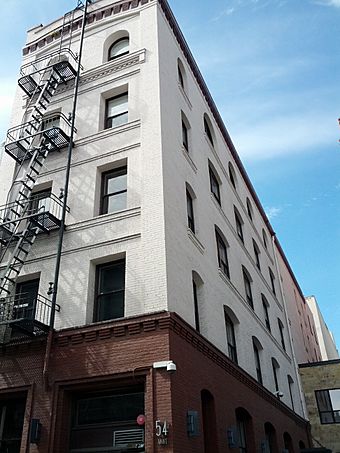- This page was last modified on 17 October 2025, at 10:18. Suggest an edit.
George Haas & Sons facts for kids
|
Haas Candy Factory
|
|
 |
|
| Location | 54 Mint St., San Francisco, California |
|---|---|
| Area | less than one acre |
| Built | 1906 |
| Architect | William Curlett |
| Architectural style | Early Commercial |
| NRHP reference No. | 00001622 |
| Added to NRHP | January 8, 2001 |
George Haas & Sons was a well-known candy company in San Francisco, California. This business grew to have four different stores. One of these, located in the Phelan Building, was even called the most beautiful candy store in the United States. It was so famous that it appeared on historic postcards! The Haas company also had a cozy tea room on the second floor of their building. Today, the Haas Factory Building is a special historic place, listed on the National Register of Historic Places (NRHP).
Contents
A Sweet History: George Haas & Sons
George Haas & Sons was a popular name in the candy world. They were famous for their delicious sweets and beautiful shops. The company made a big mark in San Francisco's history.
The Famous Candy Stores
The Haas company opened several stores across the city. Their most famous shop was inside the grand Phelan Building. This store was designed to be very fancy and welcoming. People loved to visit it for its beauty and, of course, its tasty candies.
The Phelan Building store also featured a special tea room. This was a lovely spot where people could relax and enjoy a cup of tea. It was a perfect place to meet friends or simply take a break.
The Haas Candy Factory Building
The building where the Haas Candy Factory once operated is located at 54 Mint Street. This address is in the South of Market neighborhood of San Francisco. The factory building itself is quite old and has a unique design.
A Historic Landmark
The Haas Candy Factory building is recognized as an important historical site. It is officially listed on the National Register of Historic Places. This means it is a place that has played a significant role in the past. The building was completed in 1906. Its architect was William Curlett.


